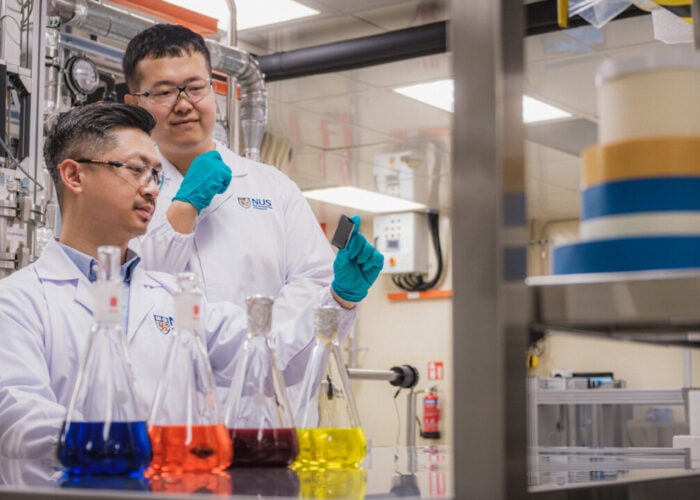
Scott Graybeal serves as CEO at Caelux, a pioneer in utilising perovskites to make solar energy more powerful and cost-effective, enabling the next generation of solar innovation.
The US solar market is surging.
Unlock unlimited access for 12 whole months of distinctive global analysis
Photovoltaics International is now included.
- Regular insight and analysis of the industry’s biggest developments
- In-depth interviews with the industry’s leading figures
- Unlimited digital access to the PV Tech Power journal catalogue
- Unlimited digital access to the Photovoltaics International journal catalogue
- Access to more than 1,000 technical papers
- Discounts on Solar Media’s portfolio of events, in-person and virtual
Thanks to several factors, including the financial incentives built into the Inflation Reduction Act (IRA), the US solar industry will install a historic 32GW of new solar-generated electricity capacity in 2023, a 52% year-over-year increase.
In many ways, that’s just the tip of the demand iceberg. Of non-solar households, 67% say they are interested in installing solar power solutions, citing a desire to lower their electric bills as the top reason they are considering solar power right now.
Solar energy is no longer a novelty. It’s a widely embraced technology integrated into our energy portfolio with room to run.
This is excellent news for the environment, economy, and communities. It’s also a call for continued innovation to propel this technology forward, making solar more functional, cost-effective, and diversified than ever before.
On that front, perovskites present enormous potential to elevate solar power potential in the years ahead.
The market opportunity for perovskites
Today’s solar market is predominantly shaped by silicon-based photovoltaics, commonly found in rooftop solar installations and expansive solar farms.
Solar power is nestled within a broader portfolio of climate technology solutions. These include wind energy (terrestrial and offshore), energy storage innovations that capture and distribute renewably generated electricity on demand, and grid enhancements for efficiently transporting green energy.
Except for transmission upgrades, all these technologies share a core need: affordable, large-scale green electricity.
This creates a market opportunity for perovskites, a class of synthetic nanomaterials that produce low-cost yet highly efficient solar devices that make traditional silicon modules more powerful.
The advantages of perovskites lie in their low production costs, low processing temperatures (thus less energy intensity in production), and compatibility with automated, streamlined manufacturing processes. In essence, perovskites deliver powerful solar solutions affordably.
In the longer term, perovskites will likely replace silicon as the go-to material for photovoltaics. This shift can help us avoid supply chains marred by ethical labour concerns and lengthy, carbon-intensive transportation. The primary hurdle for perovskites is their durability, but firms like Caelux and various global research labs are proving it is more of an engineering issue than a fundamental limitation. With these advancements, we can anticipate a considerable reduction in solar installation costs in the US within the next decade.
As a result, their potential extends to electric vehicles, satellites, building-integrated solar applications, IoT (Internet of Things) devices, and many other applications.
As MIT News explains, “Perovskites hold promise for creating solar panels that could be easily deposited onto most surfaces, including flexible and textured ones.”
It can also play a pivotal role in rural electrification.
With their potential for compact manufacturing, perovskites suggest a future where small automated factories can be transported to underserved regions worldwide. These factory modules, possibly the size of shipping containers, could use local raw materials to produce affordable and efficient solar panels. Such a vision suggests a shift from long-lasting but complex solar systems to more affordable, locally-produced, and easily installed alternatives, untethered from complex supply chains.
However, hurdles remain to implementation at scale, requiring continued development to make perovskites commercially competitive with photovoltaics and other solar products.
Challenges to perovskite implementation
The primary hurdle in embracing perovskites lies in our collective determination.
From 2005 to 2015, during what some label as Cleantech 1.0 and PV 2.0, the focus was on photovoltaic innovation. Significant capital flowed into this sector, but many assumptions proved misguided. Dominance was established by crystalline silicon (C-si), especially from China, and to a lesser yet important extent, Cadmium-Tellurium (CdTe) solar. C-si pushed everything else to the side, and many other investments, notably in thin film silicon and CIGS, suffered losses due to several factors, including:
- Physics Barriers: CIGS and thin-film silicon had limited scope for efficiency improvement compared to crystalline silicon, pushing the focus towards cost-efficiency, which was undermined by the need for complex facilities and expensive capital equipment.
- High Capital Equipment Costs: State-of-the-art turnkey thin film silicon manufacturing capital equipment costs US$1.00 per watt, maybe as low as US$0.85 per watt for highly competitive manufacturing projects- before facilities considerations. The best CIGS production lines cost around US$0.70 per watt at 100MW scale. In contrast, China’s crystalline silicon industry consistently drove down its costs, reaching well below $0.15 per watt today from wafer to module (some would include polysilicon production in this figure).
- Denial: Many in the industry either underestimated China’s advancements or chose to ignore them. China’s plummeting module and silicon prices surprised US and European manufacturers, wiping out concentrating PV and thin film prospects.
Instead of lamenting the success of Chinese photovoltaic producers, we should recognise that they have masterfully utilised Wright’s Law: costs decrease with increased cumulative production by a fixed rate.
For crystalline silicon PV, this rate is around 15%– for every doubling of cumulative output, costs decline by 15% (some sources will say 10%, others 20%.) Leveraging this knowledge, China’s strategic national and provincial policies, plentiful capital, and robust domestic supply chains placed it at the pinnacle of PV innovation. Chinese manufacturers out-built the West, produced more and learned faster as the math would predict.
However, the horizon still holds promise for perovskites:
- Overcoming Physics Barriers: Perovskites are not restrained by the same efficiency ceilings as previous thin-film technologies. The theoretical efficiency for single and tandem junction perovskite cells is about 33% and 38%, respectively. While challenges persist, they are engineering hurdles rather than scientific barriers. It’s worth noting that for perovskites, a similar learning rate to crystalline silicon is observed by Caelux and is correlated to key performance parameters.
- Affordable Capital Equipment Costs: Perovskites demand far less investment than previous thin-film technologies. Perovskites processing equipment costs are about US$0.05/Wp at 500MW scale, far less than the US$0.70 to US$1.00 per watt for legacy technologies, thus mitigating the risk for investors by comparison and accelerating payback periods.
- Informed Approach: Today’s industry is better informed and maintains a watchful eye on global competition, adhering to Andy Grove’s wisdom: “Only the paranoid survive.” Companies and governments need to capitalise on opportunity, and move with alacrity while being intentionally mindful of advancements of off-shore competitors.
The technical challenges are temporary hurdles to successful implementation. In many ways, the real missing ingredient is leadership.
How to make perovskite leadership a reality
Perovskite nanomaterials stand at the cutting edge of photovoltaic technologies. It’s essential to note that Western enterprises face fierce competition from well-resourced and technically advanced rivals globally. Instead of being daunted, this should energise our efforts. Evidence already exists of perovskite modules efficiently generating electricity at reduced costs. With this groundwork, the Western perovskite producers can strategically accelerate the technology’s advancement:
- Global Roadmap Awareness: We must recognise and adapt to the global landscape of technological progression. Many perovskite enterprises and Western policymakers are satisfied with developing devices smaller than one square meter– half the size needed for viable commercial application for four-terminal tandem or single junction applications. As global competitors advance to commercial scale, US and European companies need to stretch from lab to fab–quickly.
- Promote Real-World Testing: It’s crucial to support testing perovskite modules outdoors with both government-sponsored and independent test facilities, while driving pilot testing in third-party financed solar projects.
- Prioritise Technical Education: Our industry requires a workforce adept in mechatronics, logistics, and factory operations. These are lucrative roles that will drive a renewed, manufacturing-focused economic model. Additionally, refining immigration policies will ensure we attract and retain top-tier talent to boost innovation.
A pivotal aspect of leading in perovskite technology involves our representatives prioritising high-tech manufacturing. The US has previously benefited from unified and dynamic industrial policies, with the interstate highway system and the Apollo Program exemplary achievements from the last century. More recently, the IRA, direct demand, loan assurances, and state incentives have spurred commercial space exploration and electric vehicles.
Perovskites represent the next significant innovation. The opportunity is before us; it’s time to grasp it.







